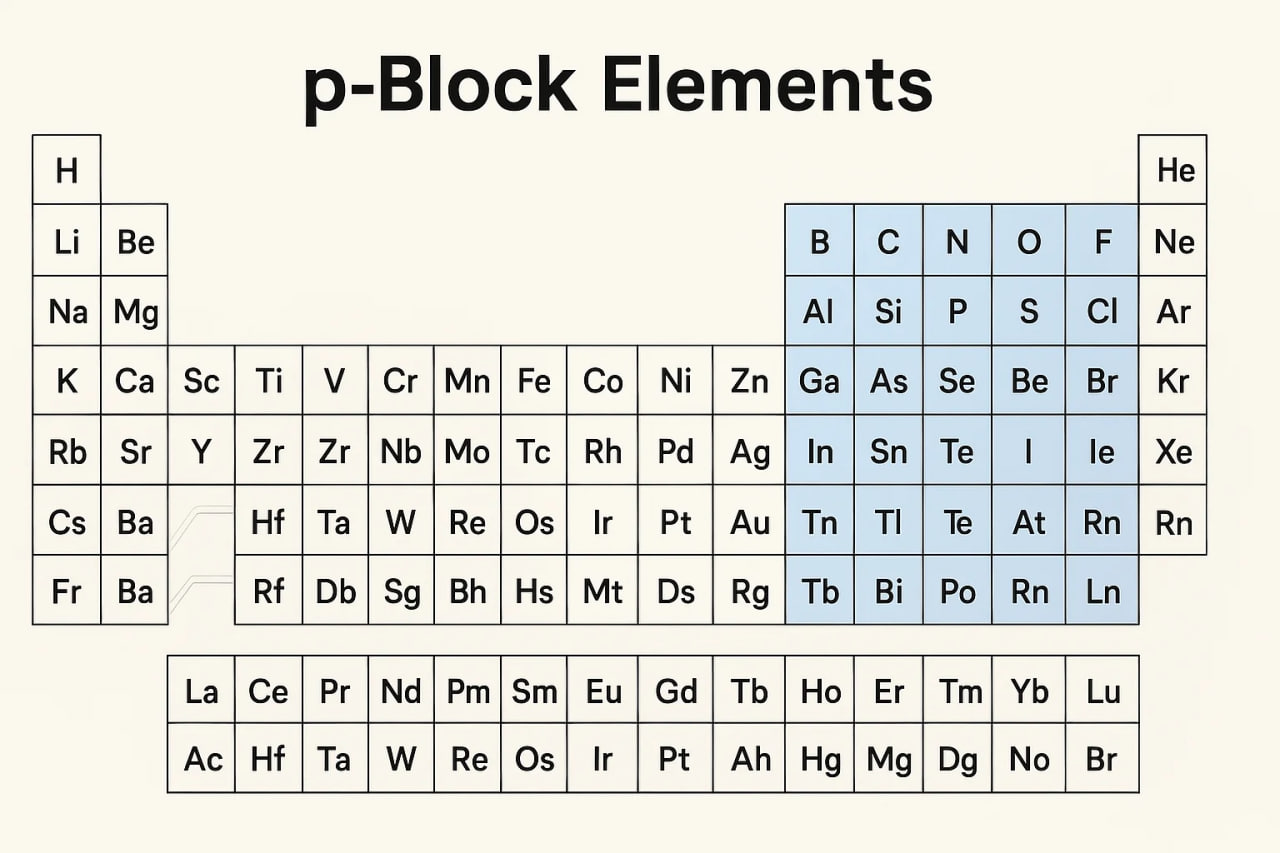Bullet Notes
D-Block Elements (Transition Metals):
- Located in the middle of the periodic table, between the s-block and p-block elements.
- Filling of the d orbitals occurs from periods 4 to 7.
- Commonly referred to as transition metals due to their variable oxidation states and ability to form colored compounds.
- Typically have high melting and boiling points.
- Good conductors of heat and electricity.
- Often form stable complexes with ligands in coordination chemistry.
- Prominent members include iron (Fe), copper (Cu), and zinc (Zn).
- Exhibit a wide range of oxidation states due to the availability of multiple d orbitals for electron configuration.
- Often used as catalysts in chemical reactions.
- Frequently found in the form of alloys due to their ability to improve the properties of metals when combined with them.
F-Block Elements (Lanthanides and Actinides):
- Located at the bottom of the periodic table, separated from the main table due to space constraints.
- Lanthanides are found in period 6 and include elements from cerium (Ce) to lutetium (Lu).
- Actinides are found in period 7 and include elements from thorium (Th) to lawrencium (Lr).
- Lanthanides are known for their similar properties and are often referred to as the “rare earth elements.”
- Actinides are known for their radioactivity, with uranium (U) and plutonium (Pu) being well-known examples.
- Both lanthanides and actinides have partially filled f orbitals.
- Lanthanides are used in various applications, including the production of strong magnets and phosphors for color television screens.
- Actinides have important uses in nuclear energy and weapons production.
- Many actinides are highly unstable and radioactive, posing significant health and safety hazards.
Terms and Definitions
D-Block Elements:
- Transition Metals: Elements found in the d-block of the periodic table that exhibit variable oxidation states and often form colored compounds.
- Oxidation State: The electrical charge an atom would have if electrons were transferred completely during the formation of a chemical compound.
- Coordination Complex: A compound composed of a central metal atom/ion bonded to surrounding atoms or molecules (ligands) through coordinate bonds.
- Catalyst: A substance that increases the rate of a chemical reaction without being consumed in the process.
- Alloy: A mixture of two or more elements, at least one of which is a metal, that has desirable properties different from its constituent elements.
- Valence Electrons: Electrons in the outermost energy level of an atom that are involved in chemical bonding.
F-Block Elements (Lanthanides and Actinides):
- Lanthanides: A series of 15 elements from cerium (Ce) to lutetium (Lu), located in period 6 of the periodic table, characterized by the filling of 4f orbitals.
- Actinides: A series of 15 elements from thorium (Th) to lawrencium (Lr), located in period 7 of the periodic table, characterized by the filling of 5f orbitals.
- Rare Earth Elements: Synonymous with the lanthanides, they are a group of chemically similar elements often used in the production of strong magnets and phosphors.
- Radioactivity: The property of certain elements (actinides) to spontaneously emit radiation as a result of unstable atomic nuclei.
- Nuclear Fission: The splitting of a heavy atomic nucleus (e.g., uranium-235) into smaller nuclei, accompanied by the release of a large amount of energy.
- Isotope: Atoms of the same element that have the same number of protons but different numbers of neutrons, resulting in different atomic masses.
- Half-Life: The time it takes for half of the radioactive atoms in a sample to decay into a stable form.
- Transuranium Elements: Elements with atomic numbers greater than uranium (92), typically produced artificially in nuclear reactors or particle accelerators.
Lanthanide Contraction
The term “lanthanide contraction” refers to a phenomenon observed in the periodic table, specifically in the lanthanide series of elements. The lanthanide series includes the 15 elements from cerium (Ce, atomic number 58) to lutetium (Lu, atomic number 71). Lanthanides are part of the f-block elements and have their 4f orbitals progressively filled with electrons.
The lanthanide contraction is characterized by a consistent decrease in the atomic and ionic radii of the elements as you move across the lanthanide series from left to right. In other words, as you go from cerium to lutetium, the atoms and ions of these elements become progressively smaller.
The lanthanide contraction can be explained by the filling of the 4f orbitals. The 4f electrons are relatively poor at shielding the increasing positive charge of the nucleus as you move across the series. As a result, the effective nuclear charge experienced by the outermost electrons increases, leading to a stronger attraction between the nucleus and the outermost electrons. This stronger attraction causes the electrons to be pulled closer to the nucleus, resulting in a decrease in atomic and ionic radii.
The lanthanide contraction has several important consequences in chemistry:
- Similar Chemical Properties: Lanthanides exhibit similar chemical properties due to their nearly identical electron configurations. This similarity makes it challenging to separate them through chemical processes.
- Coordination Chemistry: In coordination compounds, the lanthanides often form complexes with similar coordination geometries and ligands due to their similar sizes and properties.
- Separation Challenges: Separating and purifying individual lanthanide elements can be difficult because of their similar properties and close atomic sizes. Complex separation methods are required for their extraction.
The lanthanide contraction is a phenomenon where the atomic and ionic radii of elements in the lanthanide series decrease progressively due to poor shielding of the increasing nuclear charge by the 4f electrons. This leads to similar chemical properties among the lanthanides and presents challenges in their separation and purification.
Quiz


